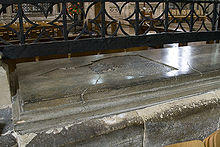Simon of Ghent | |
|---|---|
| Bishop of Salisbury | |
 Simon's tomb in Salisbury Cathedral | |
| Elected | 2 June 1297 |
| Term ended | 2 April 1315 |
| Predecessor | Nicholas Longespee |
| Successor | Roger Martival |
| Other posts | Archdeacon of Oxford; Chancellor of the University of Oxford |
| Orders | |
| Consecration | 20 October 1297 |
| Personal details | |
| Died | 2 April 1315 |
| Denomination | Catholic |
Simon of Ghent (or Simon de Gandavo; died 1315) was a medieval Bishop of Salisbury in England.
Simon was a prebendary of the diocese of Salisbury and Chancellor of Oxford University,[1] as well as Archdeacon of Oxford.[2]
Simon was elected bishop on 2 June 1297 and consecrated on 20 October 1297 at Canterbury[3] He died on 2 April 1315.[4]
Citations
- ^ Hibbert, Christopher, ed. (1988). "Appendix 5: Chancellors of the University". The Encyclopaedia of Oxford. Macmillan. pp. 521–522. ISBN 0-333-39917-X.
- ^ British History Online Archdeacons of Oxford. Accessed on 30 October 2007.
- ^ British History Online Bishops of Salisbury. Accessed on 30 October 2007.
- ^ Fryde, et al.,Handbook of British Chronology, p. 270.
References
- British History Online Archdeacons of Oxford accessed on 30 October 2007
- British History Online Bishops of Salisbury accessed on 30 October 2007
- Fryde, E. B.; Greenway, D. E.; Porter, S.; Roy, I. (1996). Handbook of British Chronology (Third revised ed.). Cambridge: Cambridge University Press. ISBN 0-521-56350-X.
| Academic offices | ||
|---|---|---|
| Preceded by John of Monmouth | Chancellor of the University of Oxford 1291–1293 | Succeeded by Henry Swayne? or Roger de Martival |
| Catholic Church titles | ||
| Preceded by Nicholas Longespee | Bishop of Salisbury 1297–1315 | Succeeded by Roger Martival |